Ground Reports
First-Person Account: Being In Ayodhya For Pran Pratishtha On January 22
Swati Goel Sharma
Jan 27, 2024, 05:55 PM | Updated Aug 13, 2024, 03:47 PM IST
Save & read from anywhere!
Bookmark stories for easy access on any device or the Swarajya app.
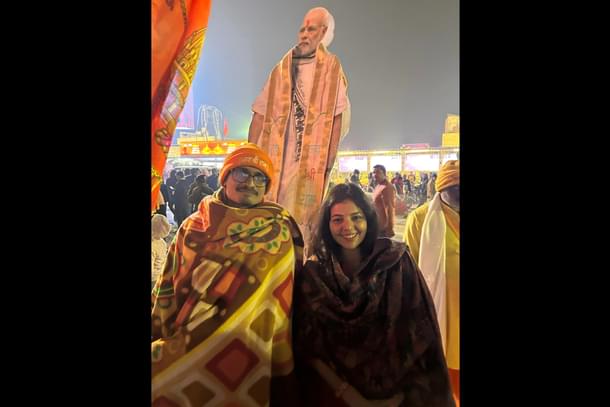
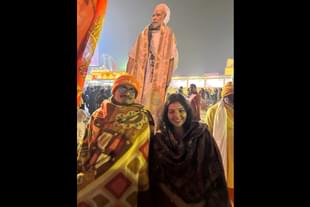
As the sun began to set on 22 January, I exited the Ram Janmabhoomi temple in Ayodhya. Passing through an ornately decorated gate about 300 meters from the temple's inner sanctum, the 'garbha griha', I saw queues of tens of thousands of devotees lining both sides of the road.
Policemen were omnipresent, trying to prevent the crowds from spilling onto the roads. No autorickshaws were operating, and so I proceeded to walk to my hotel, located about 1.5 kilometres away.
In a gesture that left me bewildered, individuals from the queue stepped out to touch my feet. A man explained, “Having had darshan of Ram Lalla, you are divine to us.”



It was in that moment that the enormity of being fortunate to be given an invitation to the Pran Pratishtha ceremony dawned on me. A limited number of guests were granted entry to the temple that historic day.
The sea of devotees on the road, with their boundless devotion for the temple and its deity, Ram Lalla, saw divinity in a mere mortal like me simply because I had caught a glimpse of his murti.
The walk to the hotel unfolded like a grand procession. Whenever people weren't attempting to touch my feet, they were bestowing garlands and cascading petals. Loud, spirited chants of 'Jai Shri Ram' filled the air.
Police were urging the devotees to return to their accommodations and to come back the following day as darshan had been closed for the day. This directive was met not with anger or frustration but with peaceful acceptance, as the crowd erupted into Ram bhajans.
Nobody seemed inclined to leave.
I came across a group of 15-20 Sikhs joyfully performing bhangra. I joined them, briefly, before proceeding to my hotel.
The room was modest, offering just enough space for a bed and two chairs. That night, securing a hotel room in Ayodhya was a luxury achievable either through contacts or by paying five to six times the usual rate.
Back in the streets a few minutes later, I found myself in an entirely transformed city. As evening set in, the residents and shopkeepers had illuminated the streets. Ayodhya seemed bathed in the glow of lights.
Everywhere I looked, there were women adding final touches to rangolis, men were busy fixing lights, and children were placing diyas and candles or, in some areas, bursting crackers.
The sight seemed to make the phrase, ‘Awadh mein Ram aaye hain’ (Ram has returned to Awadh), alive. By that time, I had received on my phone visuals of celebrations across India – in villages, towns and urban housing societies.
However, I knew that something extraordinary was unfolding in Ayodhya with no parallel elsewhere.
The city seemed to be entirely consumed by the festivities, as if there was no space for anything else that evening. The atmosphere was so uplifting it felt like no one could harbour resentment in their hearts.
I decided to experience this celebration as late in the night as I could.
At Ram ki Pairi, two young men from Bhopal told me they endured a five-hour walk to reach Ayodhya. Abhishek and Nikhil alighted at Sultanpuri railway station and followed the railway tracks to arrive in the city.
Asked why they did not wait for a few weeks when train services were normal, they replied, “Jaise bhi aaye, par hamara aana saphal aa gaya. Hum Ram ki nagari mein aakar dhanya ho gaye (No matter how we came our journey has become successful. We feel blessed having come into the city of Ram).” (Readers may watch a video of Abhishek and Nikhil here).
Two youths from Mumbai, Pranay Niwate and Raj, too had arrived in Ayodhya after a five-hour walk from Sultanpuri station. They said their only goal was to experience the atmosphere in Ayodhya on Pran Pratishtha day.
"We did not know where we would stay, or whether we would reach in time at all. But here we are, enjoying every moment of it," said Niwate. (Readers may watch a video of Pranay and Raj here).




I had learnt the previous night that Ayodhya was not entirely sealed off to those without an invitation for the ceremony. Although entry of vehicles into Ayodhya required invitation cards, tens of thousands of devotees had managed to enter on foot, navigating through railway tracks or agricultural fields.
I was reminded of early 1990s when lakhs of ‘karsewaks’ had similarly entered Ayodhya despite restrictions on trains and buses, some taking as long as seven days.
A police officer informed me that an estimated five lakh 'outsiders' were in Ayodhya on the evening of 22 January. I calculated that this number was roughly equivalent to the karsewaks present in the city on 6 December 1992, when the Babri structure was demolished.
In conversations with various visitors, stories emerged of the lengths they had gone to gain entry into the city on this long-awaited momentous occasion.
One individual mentioned that he recited the entire Hanuman Chalisa before he was granted entry by police. Another said he began crying and was permitted to enter.
A Bihar native, Ratan Ranjan, came to Ayodhya from New Delhi on a cycle fitted with a life-sized cutout of Prime Minister Narendra Modi. It took him seven days. Despite lacking an invitation or pass, he too was granted entry.
"Ram has come to Ayodhya after 500 years. How could I bear to stay away," said Ranjan. Explaining the cutout, he said, "This would not have happened without Modi." (Readers may watch a video of Ranjan here).
Many said they had ventured alone but found friends in the city.
Ayodhya, on this night, was a sprawling festival ground, a place where, it seemed, no one was left wanting for food, shelter or company.
At almost every 50 meters, there was a ‘bhandara’, distributing free food, tea and water.
I reached a 'sewa shivir' (service camp) established in memory of the ‘Kothari brothers’ by a Kolkata-based trust named after them. Ram and Sharad Kothari had come to Ayodhya in 1990 on a call by Vishwa Hindu Parishad for karseva, but were brutally killed by police.
Poornima, their sister and the only surviving member of the family, had been helming the camp for more than a week, accompanied by her daughter Yashi. The camp had been offering tea and breakfast to passers-by.
She shared with me that she had been away from her home in Kolkata for two weeks at that point, having participated in events across the country to talk about the sacrifices of her brothers. “Today is the biggest day of my life,” she said, referring to her darshan of Ram Lalla earlier in the day.

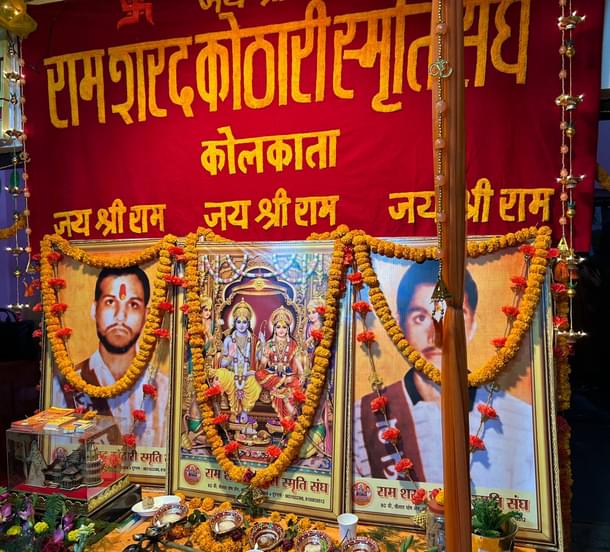
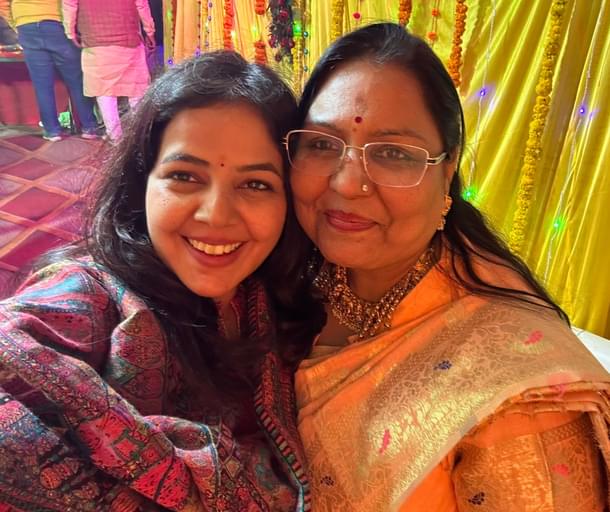
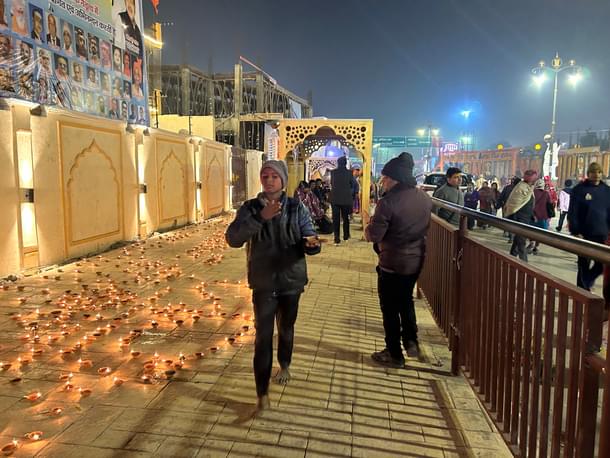
One of my objectives that evening was to meet Baba Harjit Singh Rasulpur, the leader of a group of Nihang Sikhs from Punjab, who has been running a ‘langar sewa’ (community kitchen) in Ayodhya for several weeks.
Harjit Singh’s forebear, Baba Fakir Singh, had in the 1850s undertaken the bold endeavour of entering the Babri structure with about 40-50 Nihangs. They camped in the structure and performed ‘hawan’ for 10 days beneath the central dome before being forcibly removed on the order of the court.
Baba Harjit Singh is eighth in the lineage of Baba Fakir Singh.
The camp, located in the Char Dham mutt, was quiet by the time I arrived, and he had retired for the night. His manager informed me that the group planned to remain in Ayodhya for the next two months.
Deciding to visit Ayodhya with my family in this time period, I departed.
My day had been quite long, starting with my arrival at the Ram Janmabhoomi gate four hours before the muhurt for Pran Pratishtha at 12.30 pm. Entry was smooth and straightforward, requiring only our invitation and Aadhar cards.
In the walk to the main temple from the gate, visitors greeted each other with ‘Jai Shri Ram’. To everyone's delight, mobile phones and bags were permitted inside.
Just outside the temple, seating was divided into several blocks. Before PM Modi’s arrival around 12 pm, invitees mingled and took photos. With his arrival, the atmosphere shifted. People seated themselves, and Ram bhajans filled the air.
As the Pran Pratishtha ceremony commenced and was broadcast on large screens, almost everyone watched intently. When the ceremony concluded and Ram Lalla’s image appeared on the screens, joyous chants of Jai Shri Ram erupted, complemented by two army helicopters showering petals overhead.
When PM Modi finally appeared before the audience, almost everyone stood up and cheered loudly. The long wait was over.
Late in the evening as I walked in the streets and talked to people, Modi was on everyone’s lips. A woman said, “Ayodhya has got its Ram temple because of Modi.”
Meanwhile, the crowd outside the temple gate had only grown larger. I learned that the devotees planned to spend the entire night outside the gate, hoping to be among the first to enter the next day. No one was complaining; they had Ram bhajans to keep their spirits high.
As I write this piece, I can recall the bhajan 'Shri Ram Chandra Kripalu Bhaja Mana…' playing continuously in the city.
I had been part of history being created.
Swati Goel Sharma is a senior editor at Swarajya. She tweets at @swati_gs.





